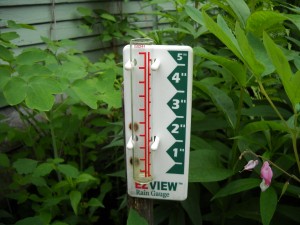Gardening in the Rain
I’ve always preferred sunny days, both as a boy and now, as a quasi-geezer. I remember reciting this ditty as a small boy, “Rain, rain, go away, come back some other day!” And it did, eventually – but usually not as quickly as I wanted. Now as a gardener I appreciate the rain for what it does for my plants, but I still think to myself, after a few hours of rain, “Rain, rain, go away …”
If you don’t have a rain gauge, you should. It doesn’t have to be one of those fancy electronic ones that sends signals to you from outdoors. A simple $5 device that consists of a cylinder with marks on the side to show each quarter inch of rain is just fine. And, if you really want to be frugal, an empty cat food or tuna can will work. Most of our plants need an inch of rain – or water from your hose – each week.
Plants are generally the most susceptible to death by dehydration right after planting. Their roots have been disturbed and frequently delicate root tips have been broken off. A hot, dry day can wreak havoc on a newly planted seedling. If your plants are growing in potting mix, it is best to submerse the plants in a bucket of water before nestling them into their growing holes. Hold the plants under the water until they stop bubbling. It can be hard to saturate a large root ball by top watering.
Rainy days are much better than sunny days for transplanting. You can minimize shock by preparing the new hole before you dig up the plant so that it can go right to its new home. My grandfather liked to say that you should move enough soil with a transplant that “it will remember where it came from.” Modern soil scientists would probably agree, saying that the soil microbes you move with a plant are important to its future health. After moving a plant, create a ring of soil around your transplant to hold water. Then, using a watering can, gently fill the ring and let water seep in. Repeat several times.
I add two solutions to my watering can that help to minimize transplant shock. The first is called SUPERthrive. It comes in a little 4oz container but it only takes a quarter of a teaspoon of the solution for a gallon of water to treat plants against transplant shock. It contains vitamins and minerals; in my experience it reduces transplant shock and helps stressed plants (like those 6-packs of annuals I forgot to water on a hot day).
The other solution I use is a liquid fish and seaweed fertilizer. Neptune’s Harvest makes a very nice product, though there are plenty of others. The fish “juice” gives new plants nitrogen, phosphorous, potassium and trace minerals at a time when they need a quick burst of soluble fertilizer.
But back to those rainy days: if you don’t mind working a warm rain, go outside and weed. Weeds pull much more easily when the soil is wet. But avoid a lot of digging in wet soil. I like my CobraHead weeder (www.CobraHead.com), in part, because it is a low-impact tool. I can use its single tine to stir up the soil enough to plant a small lettuce plant or make a furrow for carrot seeds without making a big mess of the soil on a rainy day.
I never walk on beds when they are wet. Wet soil compacts easily, especially soils with a high clay content. Clay that is compacted and then allowed to dry out can be as hard as concrete. And don’t even think of rototilling wet soil. You can ruin the soil texture by doing so.
Most of us have plants in pots on the front stoop or on the deck. Be attentive to them when it rains. If they have drainage holes (as they should), they will collect water in their saucers below. Roots can rot if left sitting in water for days on end. So remove the plants from their saucers in a deluge, or shortly thereafter. If you notice that the runoff is brown, you are probably losing good nutrients. Pour that water in a bucket to use on a dry day to water your plants.
Want an indoor planting project on a rainy day? Get out your potting soil and a few leftover 6-packs from spring planting. Plant some lettuce seeds in those 6-packs for use in the garden once they get to be an inch or two tall. I find that starting lettuce in 6-packs and growing them on the deck is better than direct seeding in the garden – no weeds, and they are easier to monitor for water. I try to remember to plant lettuce every 2 weeks for a good supply all summer. And you can start fall broccoli by seed in mid-July- so mark your calendar today, and do so on a rainy day.
There are times in early summer when I get bone tired from doing so much gardening, day after day. I can’t seem to get it through my thick skull that I’m not a kid anymore. So a rainy day is a good thing. It usually forces me slow down a little. And my plants love them – in moderation.
Henry Homeyer is a life-long organic gardener, a UNH Extension Master Gardener, and a gardening coach. Contact him at henry.homeyer@comcast.net or P.O. Box 364, Cornish Flat, NH 03746.




